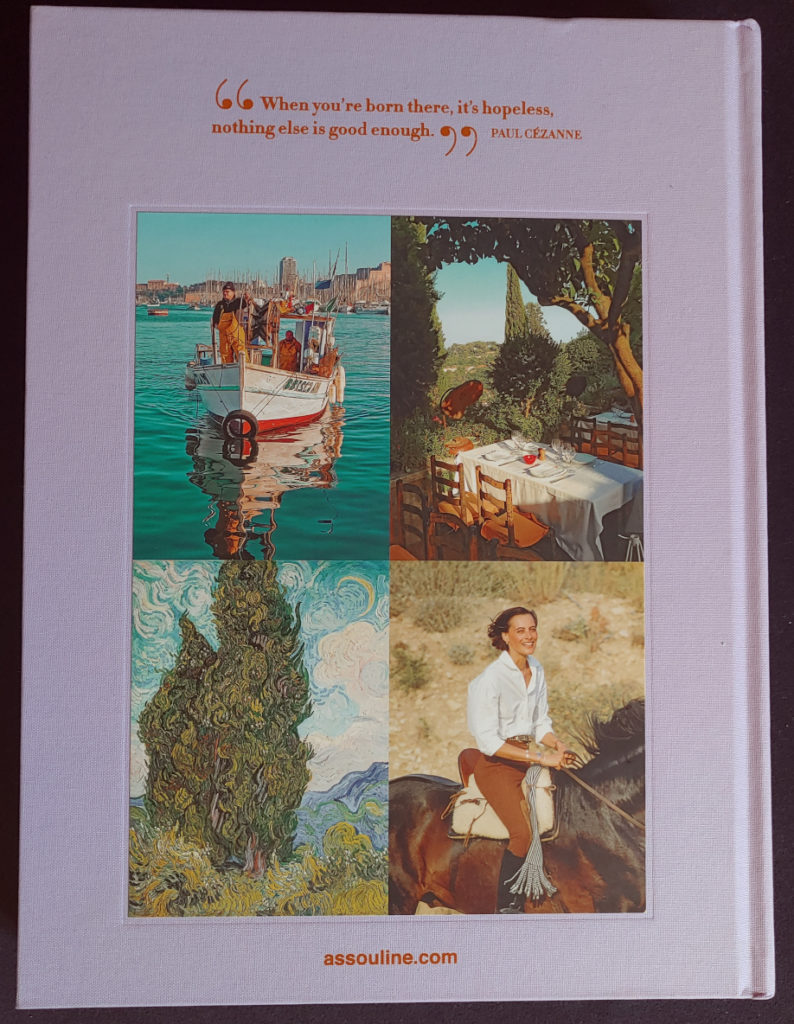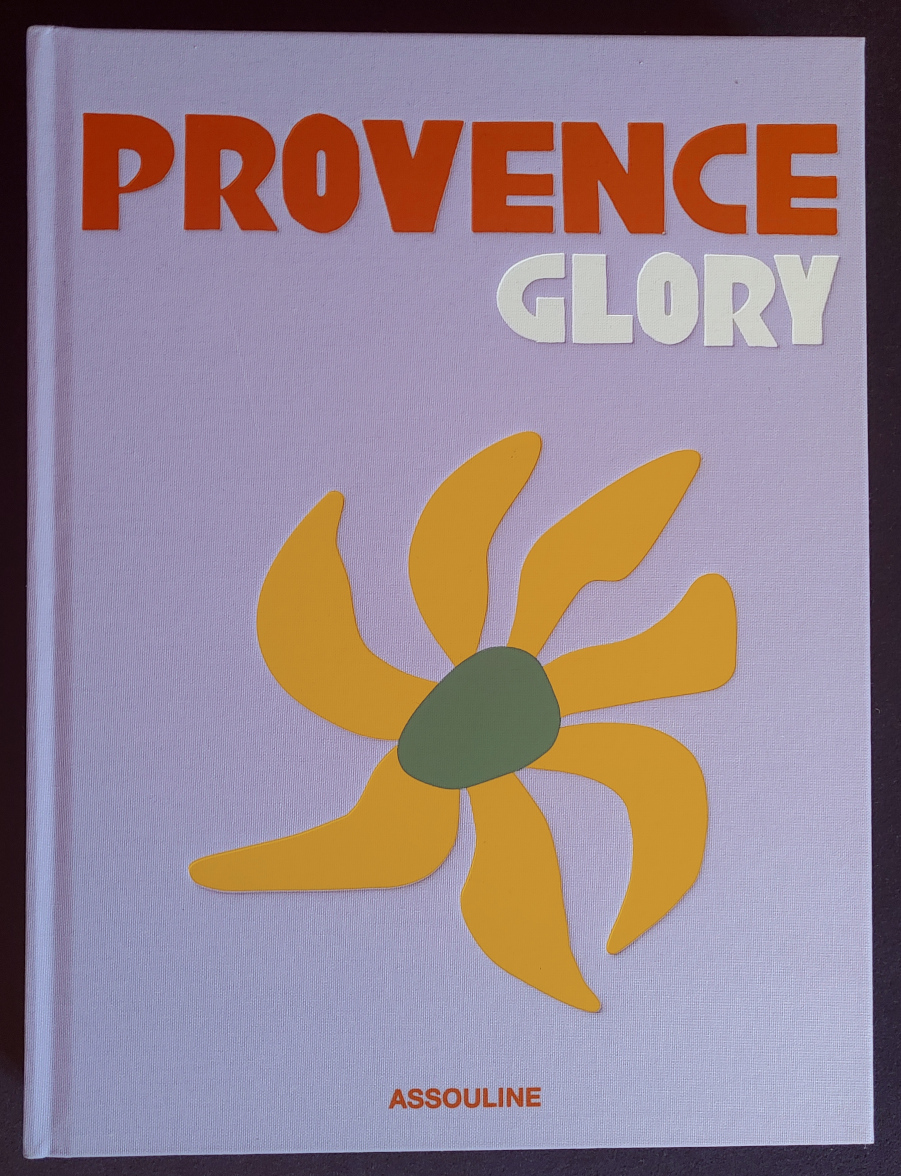Real Provence in the South of France is not the coastline Cote d’Azur, but the countryside a bit more inland from the coast. A mountainous, hot area where you can hear the crickets chirp non-stop in summer and where the lush colours from the coast change to a landscape in a completely different colour palette. The air is full of scents from herbs and flowers. It’s the land of small romantic stone towns in the hills, with kilometres of sparsely populated land where people live from agriculture and hunting, meet in the village centre to play a round of Boule or drink pastis in a bar. At least that is the picture we all have in our head through the beloved books of Peter Mayle and brilliant calendar pictures.
The cover of “Provence Glory”, a picture-rich coffee-table book, combines the famous colours of the region. Lavender lilac is the best known colour of the set, the bushes with the wonderful translucent blue-ish colour are the real symbol of Provence. Everyone knows the pictures of the Abbaye Notre-Dame de Senanque in Gordes, the endless fields of lavender leading to the stone chapel with the distinctive tower.
Sunflowers, pinetrees, cypresses, wheat fields, gold and green, come also into mind when thinking of Provence. “Provence Glory” shows the lilac set off with yellow and green, a bit ocre and white. The latter stands for the clouds and the stone buildings, I’d say. The blazing yellow symbolizes the sun itself, whose merciless heat makes the idea of a rest after lunch extremely interesting.
The feeling of Provence, before tourism took over, can be best felt in the books of Marcel Pagnol. He was born in Marseille in 1895. His parents rented a house in Provence, so every summer the family travelled – partly literally on foot with the all the luggage – to reach that home. Its where he grew up and matured and learned most about life. His “Memories of childhood – My father’s glory and my mother’s castle” is one of my most favourite books ever. There is a fantastic film version from 1990/1991 which I loved so much I bought it on DVD as well, as to never lose access to the films.
The beauty of the landscape, the poverty of many of its inhabitants, the difference of what is important to someone from the rural area to someone from the big city, the simpleness of pleasure and the happiness about life itself come alive in his descriptions. The end, though, is touchingly sad. People die, often first the most beloved ones, and good times come to an end. If you want to feel Provence without going there, the book and the films are a must.
On the back cover of the “Provence Glory” book some pictures make the feeling more tangible as well. Let’s ignore the fishermen in their boot just off the beautiful port of Marseille. Yes, I know, technically Marseille is the capital city of the region Provences – Alpes Cote d’Azur and therefore some of the coastline is rightfully included in the book, but still… It is about the inland here. Provence’s capital city is Grasse, world famous for its perfume manufacturing. Galimard, Fragonard and Molinard were all founded in Grasse and are still, after a few hundred years each, very much in business. They are the crown of French traditional perfume houses. You will encounter those companies and some of their products in the scent posts sooner or later. Grasse itself is a lovely stone city of only 50.000 inhabitants with incredible flair.

The other three pictures on the back cover of “Provence Glory” give a wonderful insight to the traditional Provence. The most dreamlike picture shows a table set for an outdoor lunch, under the trees, in the sun, with wooden chairs and more than one wineglass.
Sitting there, possibly with a full stomach, gazing at the blue heaven and the non-existent clouds, seeing sundown come and go, sipping some more wine, relaxing, unwinding from day-to-day stress – that is the best day dream to have. Maybe even better than reality, because I bet there are a few mosquitos around in the dusk…
The other two pictures give first Vincent van Gogh’s view of a Provence landscape, with green, blue, white, yellow accents and second an image of freedom, a classic beauty riding through the fields of Provence. It is a nice set there on the back cover, that captures the essence of the many beautiful pictures inside the book very well. Paul Cezanne’s quote “when you are born there, nothing else is ever good enough”, shown on the book back cover, hits target. Whilst there are thousands of beautiful places around the world, all that lilac in Provence together with the blazing sun gives it a supernatural quality.
The poetic text makes the contradictions of Provence well visible, but stays on the nice side of them. When today, meaning before Corona tourists went there, the view with lavender towards the famous chapel was almost less interesting compared to the opposite view – towards the hundreds of tourists who tried to capture that symbolic view of silence all at the same time and in orderly progressing rows. Too many foreigners crowding markets – from point of view of the foreigners. For a lot of inhabitant’s tourism made life better and earning a living less hard.
Actually, one of the funniest topics about Provence is plumbing. A tourist will not have many touchpoints on that one, but it is mentioned by every foreigner who owns a flat or a house there. Nice stories are told in the books of Peter Mayle and Marina van der Vyver, but also by a friend of mine who owns a small apartment there. All came to the same conclusion – people there are more artisans than craftsmen and getting a bathroom or a kitchen renovated requires angelic patience or family member flown in from all over the world to help. I wonder how this is seen by people who are born there. Maybe they just shrug and say – rightly – that there are more important things in life.
Provence is a wonderful place to visit for everybody and a peaceful place to live for those who can adapt to the reality of modern-day Provence. Its dreamlike quality, the Provence of old, is superbly transported through books, pictures and films. “Provence Glory” is a fantastic showcase of what makes the inland (and the coastline) a place of longing for people all over the world.
All rights to the book belong to:
Provence Glory, Assouline Publishing, Text by Francois Simon 2021, 3 Park Avenue, 27th floor, New York, USA

